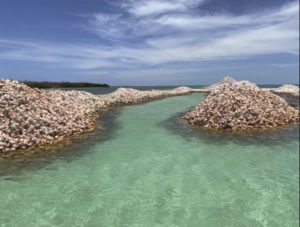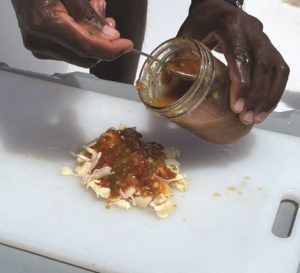The cold spring weather continues to put the fishing season on hold. Flounder are beginning to bite off the Pamet, and a few tautog are being taken around rock piles, but other than a few small schoolies along the south shore striped bass are still well south of us.
Further evidence of a warming ocean: a bottlenose dolphin was found stranded deep in the bay at Rock Harbor. IFAW got it and brought it to Herring Cove, where it was successfully released. We rarely see bottlenose dolphins in our area, as they prefer much warmer water. The dolphins here are typically the smaller white-sided species.
I spent last week in Anegada, the most northerly of the British Virgin Islands. Unlike the Caribbean islands formed by volcanic events, Anegada is part of a massive coral reef ecosystem that was built up enough to break the surface and evolve into a life-supporting land mass. Because it is not volcanic, it lacks mountains: the highest point is only 28 feet above sea level. Hence its name, which is Spanish for “flooded” or “drowned.”

Anegada is the spiny lobster and conch capital of the Caribbean. It is also home to a huge group of pink flamingos (collective noun: “flamboyance”). Many of the island’s 300 full-time residents make a living catching lobsters and conchs to export throughout the Caribbean. I have been spending time there for quite a few years now and have come to love the island and its wonderful people.
I went out to harvest conch with a local friend, Capt. Sherwood Walcott, who runs a six-pack charter fishing boat and also commercially fishes for conch. The number of conchs that live in these waters is staggering, and there are mountains of empty shells from harvesting piled up along the shallow flats, decades in the making.
It’s pretty easy work, as fishing goes. We went to an area along the edge of a reef with a depth of 6 to 10 feet of water, and with only a mask, snorkel, and fins we simply free dove when we saw a conch and grabbed it. It reminded me of when we used to free dive for sea clams off Race Point. These conchs are big, so carrying one or two back to the boat is pretty much all you can do at one time.

Removing the meat from the shell is amazing to watch. All they use is a chipping hammer and a butter knife, and they get all the meat out quickly and skillfully without doing any real damage to the shell. The fellow I was with took a conch, cleaned up the meat, and made a delicious ceviche lunch for us. The flavors of his “secret ceviche sauce” and the tenderness of the conch meat, thinly sliced on a cutting board, were unlike anything I’d ever had, and I couldn’t get enough of it.
This is a simple island with fishermen who, unlike us, do not have to deal with the rigors and challenges of an environment with enormous pressure on fish stocks, along with strict and sometimes illogically imposed regulations. They have plenty of conch and lobster to harvest, and the number of fishermen working is such that everyone can make a decent living.
Kind of like it used to be here at home before we killed the goose that laid the golden egg.



